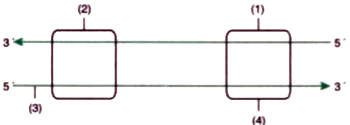DNA strands are termed antiparallel because of
H-bonds
phospho-diester bonds
disulphide (S-S bnds)
none of the above
The correct Answer is:B
Step-by-Step Solution:
1. Understanding DNA Structure: DNA is composed of two strands that form a double helix. Each strand is made up of nucleotides, which consist of a sugar, a phosphate group, and a nitrogenous base.
2. Directionality of DNA Strands: Each DNA strand has a directionality, which is indicated by the 5' (five prime) and 3' (three prime) ends. The 5' end has a phosphate group attached to the fifth carbon of the sugar, while the 3' end has a hydroxyl (-OH) group attached to the third carbon of the sugar.
3. Antiparallel Orientation: In a double-stranded DNA molecule, the two strands run in opposite directions. This means that if one strand runs from 5' to 3', the complementary strand runs from 3' to 5'. This orientation is referred to as "antiparallel."
4. Role of Hydrogen Bonds: The two strands of DNA are held together by hydrogen bonds that form between complementary nitrogenous bases. Adenine (A) pairs with thymine (T) through two hydrogen bonds, and guanine (G) pairs with cytosine (C) through three hydrogen bonds.
5. Conclusion: The term "antiparallel" refers to the orientation of the two strands of DNA running in opposite directions (5' to 3' and 3' to 5'). The presence of hydrogen bonds between the complementary bases stabilizes this structure.
6. Final Answer: Therefore, the correct answer to the question is option A: hydrogen bonds.
---
Topper's Solved these Questions
- BOOK - AAKASH SERIESCHAPTER - MOLECULAR BASIS OF INHERITANCEEXERCISE - Exercise-II (DNA finger printing)10videos
MOLECULAR BASIS OF INHERITANCE
- BOOK - AAKASH SERIESCHAPTER - MOLECULAR BASIS OF INHERITANCEEXERCISE - Exercise-III (Previous AIPMT/NEET Questions)35videos
MOLECULAR BASIS OF INHERITANCE
- BOOK - AAKASH SERIESCHAPTER - MOLECULAR BASIS OF INHERITANCEEXERCISE - Exercise-I (DNA finger printing)22videos
MOLECULAR BASIS OF INHERITANCE
- BOOK - AAKASH SERIESCHAPTER - MINERAL NUTRITIONEXERCISE - Exercise - III52videos
MINERAL NUTRITION
- BOOK - AAKASH SERIESCHAPTER - NEURAL CONTROL AND COORDINATIONEXERCISE - EXERCISE-III( PREVIOUS AIPMT / NEET QUESTIONS)33videos
NEURAL CONTROL AND COORDINATION
Similar Questions
DNA strands are termed antilparallel be cause of
View SolutionDNA strands have
View SolutionDNA strands are antiparallel because of the presence of :
View SolutionDNA strands are joined by
View SolutionWhat do you understand by the antiparallel arrangement of DNA strands?
View Solution$ The two strands of DNA run in an antiparallel directions
DNA is formed of Deoxyribose sugar. Phosphorus and nitrogen bases called purines and pyrimidines.View SolutionIn the following diagram the two DNA strands represented are ready for transcription.
Which one of the two strands of DNA has nucleotide sequence similar to mRNA that will be transcribed and why?
 View Solution
View SolutionAssertion :- Both the strands of DNA are not copied during transcription.
Reason : Both strands of DNA show antiparallel polarity.View SolutionDNA strand is synthesized in the direction
View SolutionThe two strands of DNA are not identical, but are complementary'. Explain this statement.
View Solution

